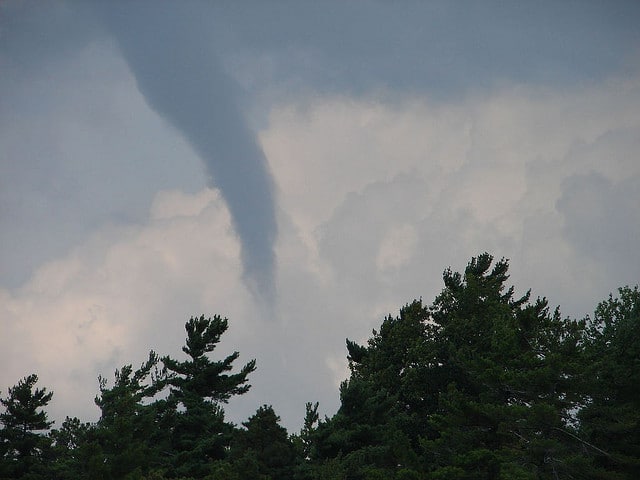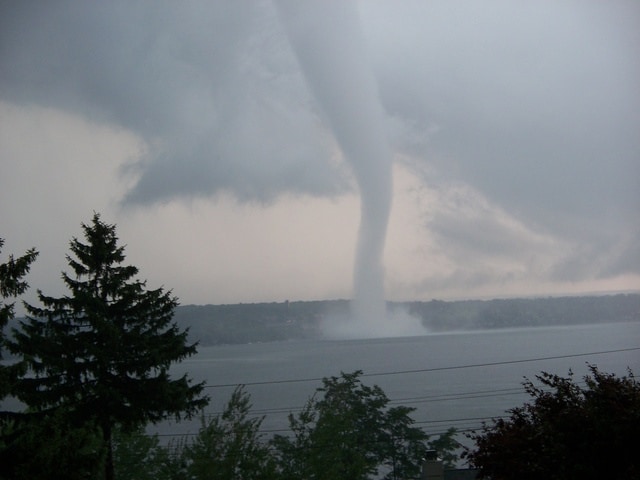There are a number of facts about tornadoes. The biggest, the meanest, the longest and of all different kinds. This marvelous yet destructive beauty of nature can be a site to look at but a chilly experience to feel. Many people are so crazy with tornadoes that they want to see it with their own eyes but none of them have been alive to tell the tale. A tornado is nothing but a giant funnel that is a fascinating sight to watch. A violent tornado, however, can leave a mass trail of destruction behind.
Below are 30 facts on Tornadoes
Fact 1: A tornado is a strong, turbulent column of fast moving air, keeping in contact with the earth’s surface. It is thus like a vertically formed cloud carrying dense water vapors, called the cumulonimbus cloud. The bottom end of the vortex is surrounded by a cloud of dust and debris.
Fact 2: Tornadoes are formed from the extremely large thunderstorms called super cells.
Fact 3: Tornadoes can be very destructive in nature with their speed ranging from 110mph to 300mph.
Fact 4: Tornadoes can last to about 1-2 hours or 4 hours, in extreme cases, and can be as tall as 75 feet.
Fact 5: Tornadoes also occasionally occur in south-central and eastern Asia, northern and east-central South America, Africa, North West and South East Europe, West and South East Australia, and New Zealand. Most commonly, tornadoes are observed to occur in the Tornado Alley, ranging from the states of Texas to Iowa, in the United States. Except Antarctica, tornadoes can occur in any place.

Fact 6: The most destructive tornado recorded till date was the one Bangladesh on April 26, 1989, which killed approximately 1300 people.
Fact 7: Bangladesh has had at least 19 tornadoes in its history killing more than 100,000 people which is almost half of the total toll in the rest of the world.
Fact 8: The most record-breaking tornado in history was the Tri-state Tornado, which spiraled through parts of Missouri, Illinois, and Indiana on March 18, 1925. It holds records for longest path length (219 miles, 352 km), longest duration (about 3.5 hours), and fastest forward speed for a significant tornado (73 mph, 117 km/h) anywhere on Earth. It has been said that that tornado was an F5, which can be extremely violent and destructive. The letter “F” is used to denote the Fujita Scale, depending on the magnitude of the damage cause by the tornado. F0 being the least amount of damage and F6 being the maximum.
Fact 9: The effects causes by tornado can be devastating and the damage caused can be one mile wide and 50 mile long.
Fact 10: The sky turns to a characteristic greenish color when a tornado is on the rising. . For the detection of tornadoes, a Pulse-Doppler radar is used which collects data based on the velocity and reflectivity of the air of the surroundings. Effects like debris balls and hook echoes are observed
Fact 11: Like anything else on this planet, everything that takes birth, must die, even the tornadoes have a definite lifecycle. They last up to 1-2 hours. The down pouring rainfall drags a rapidly descending region of air which is known as the rear flank downdraft (RFD). It drags the super cell’s Meso cyclone (area of organized rotation) to the ground with it. This RFD, when becomes cool, chokes the tornado, stopping its power source of warm air and finally dissipates the vortex.
Fact 12: The tornadoes can be of different shapes and structures. They can be either a multiple vortex tornado, or a watersoupt tornado (tornadoes occurring over a water body). Their sizes differ too. Some are rope like, thin and long, and others can be spiral and wide.
Fact 13: A tornado normally appears transparent until it picks dust and mud from the ground.
Fact 14: There are many myths and misconceptions about tornadoes too. Some believe that areas near rivers, lakes and mountains are safe from tornadoes. But the fact is that tornadoes can occur almost anywhere.
Fact 15: In the late 1980s, a tornado swept through Yellowstone leaving a path of destruction up and down a 10,000-foot mountain. It is also believed that the low pressure in a tornado causes buildings to “explode” as the tornado passes overhead. But the fact remains that, rapid winds traveling at a speed of more 200mph and the debris slams into the buildings causing most structural damage.
Fact 16: Most tornadoes spin in the cyclonic direction while some rotate in the anticyclonic direction.
Fact 17: Cyclonic is counterclockwise direction in the Northern Hemisphere and clockwise in Southern Hemisphere. Similarly, anticyclonic is a high pressure or ridge circulation in the Northern or Southern Hemisphere.
Fact 18: Most tornadoes travel few miles before they exhaust themselves.
Fact 19: Areas which are prone to tornadoes have basement shelters.
Fact 20: Tornadoes are the fastest winds on the earth and can be and their rapid rotation often form a visible funnel of condensed water.
Fact 21: Tornadoes can be formed any time throughout the year but a major number of tornadoes are formed during late April to May.
Fact 22: In the northern parts of USA, the peak session for tornadoes is much later. This is because it takes longer to warm the northern parts of the plains and hence the tornadoes form later.
Fact 23: Tornadoes can be detected through weather radar and give advanced warning.
Fact 24: Waterspouts are tornadoes that form over a body of water.
Fact 25: The United States averages around 1200 tornadoes each year.
Fact 26: During a tornado, basement and other underground areas are safest place to hideout.
Fact 27: Tornadoes are a work of creation and should always be stir-cleared away from as you never know how damaging the consequences can be.
Fact 28: Tornadoes are sometimes called Twisters.
Fact 29: Only 2% of all tornadoes are labeled as “violent tornadoes” that can last over an hour.
Fact 30: Do not open windows during severe storms as it allows dust and debris to enter the house.






